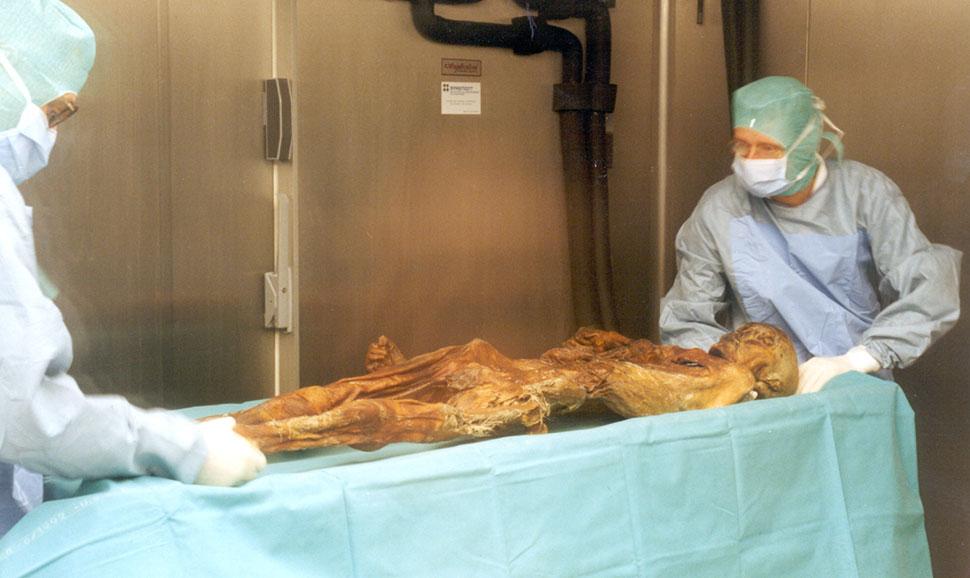ÖTZI, THE ICEMAN
One of the most important archeological discoveries of this century is certainly “Ötzi”, the mummy from the Similaun glacier. The mummy is almost 5500 years old. An entire museum was established to house Ötzi in Bolzano, and here Angelantoni Industrie reproduced the climatic conditions of the Val Senales glacier.

Ötzi was discovered by chance in September 1991 by two German tourists at an elevation of 3200 meters, in Italian territory just 92 meters from the Austrian border. The importance of the discovery lies in the fact that the body of a man, who lived almost 5500 years ago and is estimated to have been 40 years old, has been preserved virtually intact, protected by the ice. The man, whose life was cut short by the cold and whose body has survived to the present day thanks to ice, needed to return to the “kingdom of cold,” and the “kingdom of cold” is surely represented by the futuristic equipment made by Angelantoni for the preservation of the mummy.
The main difficulty to be overcome in the designing stage was reproducing the environment in which the mummy had been preserved for over 5000 years.
The climatic conditions to be simulated were a temperature of -6°C (relatively easy), but with close to 100% humidity, such as that found inside the ice, ensuring the greatest accuracy in checking the measurements. This was necessary to prevent the mummy from being dehydrated and losing some of its weight.
The project was therefore a real technological challenge for Angelantoni, which began building a prototype in the spring of 1996. The prototype was tested for a few months with a sample mummy inside, and in the summer of 1997 the International Commission authorized Angelantoni to build the complete climatic system.
An entire museum, the South Tyrol Museum of Archeology, was established for Ötzi in Bolzano in the former Bank of Italy building. Angelantoni Industrie successfully met the challenge to preserve a man from the past and put his mummy on display for all future generations.

Provides refrigeration equipment and technological solutions for the biomedical field, with a constant commitment to innovation and biological and environmental safety.
The preservation system
The complete system consists of 4 chambers, each having a different function (Drawing 1).
The first chamber is located at the entrance to the laboratory and is used as a cleanroom in which the staff is decontaminated with a UV system with filtered air at class 10,000, to prevent bacteria from entering that would be harmful for the preservation of the mummy.
The laboratory chamber can operate in a temperature range down to -6°C, according to the staff’s request. The air cooling system is equipped with special filters in order to ensure an absolutely ‘clean’ environment at class 1000, with class 10 in the area where work is usually done on the mummy (Drawing 3).
The heart of the system is represented by the two chambers for the mummy, one of which serves as a fully-equipped backup for the other chamber.
Ötzi’s chamber is equipped with high security systems, such as the public viewing window with bulletproof glass, and a twin chamber installed nearby to ensure the preservation of the mummy in the event of a possible sudden failure of the first chamber.
The air cooling system for the chambers was produced in accordance with the highest technological standards in order to ensure the required performance (T = -6°C, RH = 98%). For safety reasons it consists of two entirely independent units for each room. Each unit works with an indirect cooling system in which the air temperature is regulated by means of an air-liquid heat exchanger. The coolers are installed on all walls of the chamber in a shell exchanger configuration (Drawing 2) to ensure the greatest uniformity of temperature and humidity, without forced ventilation, which would damage the mummy.
The humidity is produced through the sublimation of ice and is measured using a chilled mirror system, together with electronic devices, in accordance with the dew point control method. The lighting is based on a cold light optical fiber system integrated with ultraviolet and infrared filters to avoid the deterioration of the mummy.
Control and security systems
Ötzi’s sleep is protected by numerous security systems and alarms, all controlled by a high-tech Siemens PLC (the same used for controlling nuclear power plants).
Up to 500 logic signals, used for the compressors, automatic valves, pumps, heat exchangers, etc., can be controlled at every moment.
40 measurements are made every 250 milliseconds, mainly for temperature, humidity and pressure.
All data is acquired and stored in a Data Acquisition and Alarm Control System, including the status of the lights, the opening of the doors, and the weight of the mummy.
Ötzi, whose current weight is around 16 kg, is set on a special scale that is able to measure any change in weight below one gram.

Angelantoni Test Technologies is proud to have contributed to the mission of PRISMA, a satellite launched to study the Earth using spectroscopic techniques, entirely designed and built in Italy for the Italian Space Agency. The ACS GALILEO Large Thermal Vacuum Chamber space simulator was used to carry out environmental tests on PRISMA’s advanced hyperspectral electro-optical instrumentation, built by Leonardo and installed in the Testing Laboratory at their plant in Campi Bisenzio (Florence).








